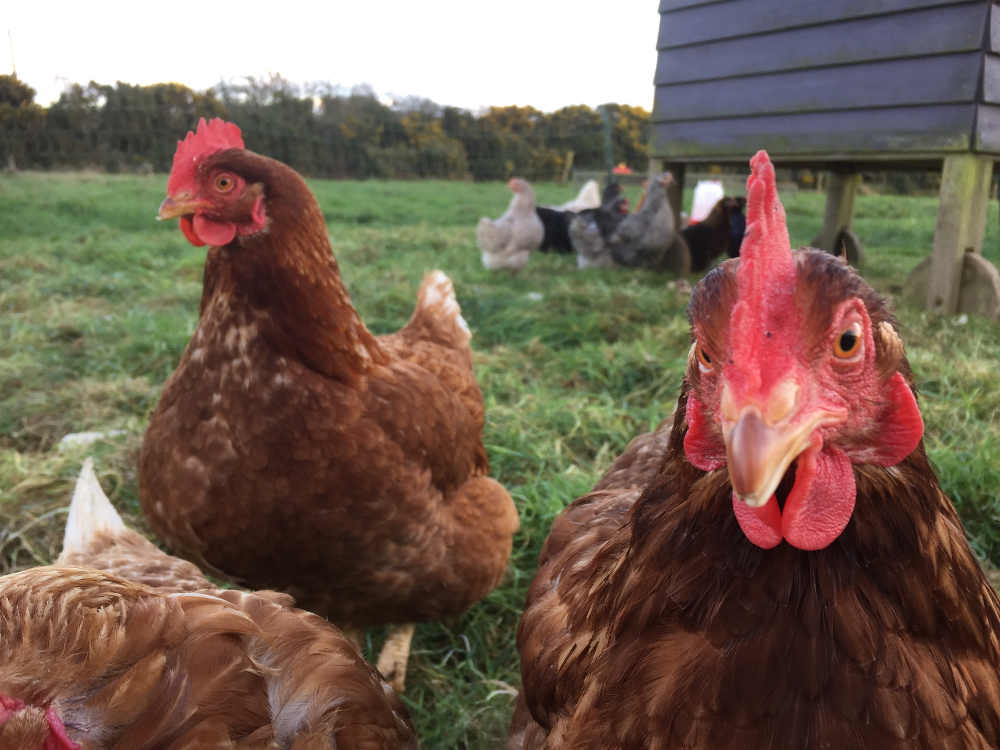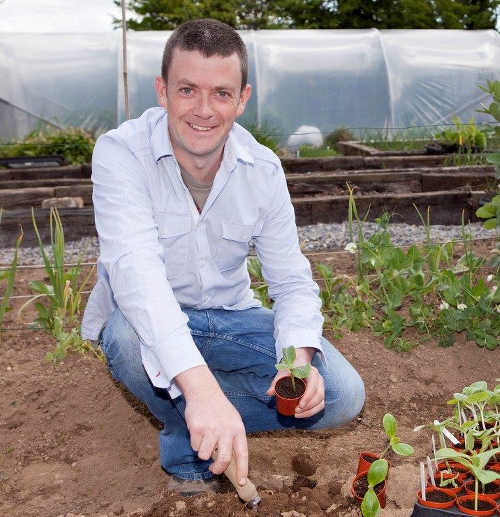Grow It Yourself - April

We added ten new hens to the flock here at home this week, ostensibly so the Eldest Child could satisfy his entrepreneurial instincts and start to sell our excess eggs. We had 5 hens up to now: 4 Rhode Island Red hybrids and a beautiful little white Leghorn who produces equally beautiful white-shelled eggs.
They were reliable layers for most of last year, but went off the boil (see what I did there?) over the last few months and we were down to one or two eggs a day over the winter – a serious thing in an egg-obsessed house like ours.
After several consecutive days of me cutting one poached egg in half to share between our two children for breakfast, Eldest Child decided to take matters in to his own hands and buy new hens to get things back on track.
As we debated how many to buy, he explained that ten extra was the perfect number so that he could start selling eggs once we’d satisfied requirements at home. He’s even started to stockpile egg cartons, a signal of the seriousness of his intent. Since he intended to buy the hens with his communion money, I could hardly refuse.
So, last weekend we took ourselves off to Kehoe’s Poultry farm just outside New Ross with a poultry crate in the boot of the car. As luck would have it Mr Kehoe had a grand selection of ‘point of lay’ (ready to start laying) hens ready to go.
Picking breeds of hens is usually a tradeoff between beauty and egg-laying reliability. You generally sacrifice one for the other. You can have a beautiful Columbian Brahma with a mad array of white feathers along its legs so it looks like it’s wearing leg warmers, but it probably won’t result in much income for the egg business.
The Rhode Island Red “Hybrid” is considered the most reliable layer of all. Given the quantity of hens we were buying, we reckoned we had some artistic licence, and opted for two each of Marans, Bluebells, Black Rock, Amber and Speckled Diamond. This required a investment of €130 but with (potentially) 70 eggs to sell a week, he won’t be long making that back.
It is always a fun if slightly turbulent time introducing new hens in to an existing, well-established flock. Hens quickly and often brutally establish and enforce a rigid pecking order so that everyone knows their place in the grand scheme of things.
The best time to introduce them to each other is at night time, so they get used to each other’s sounds in the dark when they are roosting, more placid and less prone to aggression. Closing the door, we listened and giggled at the sounds of restrained discontent and growling murmurs of bok bok bok from the elder lemons inside. Then Eldest Child went off to bed, no doubt to dream of all that egg money.
The Basics: Bringing New Hens Home
1. Young hens (called pullets) will start laying eggs generally at about 6 months – at this stage they are called ‘point of lay’ pullets. It’s an ideal time to buy them. Any earlier and you will be feeding hens that aren’t giving you an egg return. Expect to pay between €10 to €15 for a hen, depending on the breed.
2. Hens are best transported in a specialist crate or carrier, or a cardboard box if you don’t have one (firmly closed so they can’t get out, but with ventilation holes). Line the base of the box with newspaper and straw.
3. Leave new hens in their house for a few days to acclimatize and get used to their new home, particularly if they will eventually be free ranging. They need to get used to their house as their home base. Minor skirmishes are unavoidable when you bring new hens in to a flock and it takes a few days for them to establish their pecking order.
Things to do this Month - April
To Do
If poor weather in March has hampered your outdoor work, then April is the month to catch-up. The key words for April are weeds and slugs. You need to stay on top of them both. Check your early spuds regularly and ‘earth-up’ as required. Water your tunnel/greenhouse – things can get pretty warm on a nice sunny April day and seedlings will dry out quickly.

Sow
Indoors: lettuce, tomato, pepper, chilli-pepper, cucumber, celery, celeriac, basil, leeks, cabbage, cauliflower, Brussels sprouts, parsley, courgette, marrow, globe artichoke, beans, sweet corn and pumpkin.
Outdoors: broad bean, onion sets, pea, beetroot, cabbage, spinach, Brussels sprouts, parsnip, spring onion, leek, carrot, radish, broccoli, turnip. Plant out cabbage plants when they are 15/20 cm tall into well prepared soil that has been manured.
Harvest
Stored fruit and vegetables are likely to be a distant memory at this stage and new crops are only starting to trickle in which makes April a tricky proposition. The middle of this month might see the first asparagus and the first early spring cabbage. The other two star performers this month are purple sprouting broccoli and rhubarb.
Recipe of the Month – Kale and Smoked Cheddar Risotto
JB Dubois, our Head Chef at GROW HQ delivered a course on Vegetarian Cooking last month. The idea was to show people that introducing a couple of veggie dinners in to your repertoire each week can be healthy and delicious. This was one of the recipes featured. Don’t be turned off by the idea of making your own stock – it takes just half an hour to make and makes all the difference.
Serves 4.
Ingredients:
Veg Stock
• 1 small carrot
• 1 sprig thyme
• 2 cloves garlic
• 1 small leek
• 1 stick of celery
Risotto
• 250g Arborio rice
• 20g butter
• 1 clove garlic
• 1l veg stock
• 100g kale
• 1 carrot
• 100g Knockanore cheese (or other smoked cheddar)
• toasted sesame and poppy seeds
Directions:
First make the veg stock. Wash, peel and roughly chop the vegetables. Place them and the thyme in a pot, cover with 1.5l of cold water and a pinch of sea salt. Bring to the boil and simmer for 20 minutes. Remove from the heat and allow to infuse for another 10 minutes. Then pass through a fine sieve.
Wash and chop the kale. Peel and grate the carrot. Peel and chop the garlic. Grate the smoked cheddar. Sweat the garlic with the butter in a large pot on a low heat for 2 minutes. Add the rice and sweat it off for 2-3 minutes (keep stirring to avoid sticking). Add a good pinch of sea salt and pepper. Add the veg stock little by little while stirring every few minutes. The rice should be cooked when all the stock has been absorbed (15-20 minutes). When the rice is cooked, add the kale, the grated carrot and the grated cheese, give it a quick stir and serve immediately. Garnish with the toasted seeds. Add a squeeze of lemon.
Become a VIPea
By joining GIY you help us to continue the work of supporting people just like you to grow food at home, at school, in the workplace and in the community – this year we will support over 250,000 people and 8,000 community food growing groups and projects. It costs just €35 to join GIY for a year, and to say thanks we will send you a seasonal copy of our supporter’s magazine GROW and some GIY seeds for you to sow each quarter. It will also entitle you to a 10% discount at GROW HQ and our online shop. Join today at www.GIY.ie.
GROW HQ
The home of the GIY movement and our brand new food education centre, GROW HQ, is finally open in Waterford city. In addition to our 65-seat home-grown food café and shop, we’ve a range of growing and cooking courses happening weekly – for courses happening this month, check out www.growhq.org
About GIY
GIY is a not-for-profit organisation that aims to create a healthier, more sustainable world where people grow their own food. We inspire and support people to grow food more successfully by bringing them together to share advice, tips and ideas. There are approximately 65,000 people involved in the GIY movement in Ireland, which is proudly supported by Woodies DIY.
For more information check out www.giyireland.com
Michael Kelly is a freelance journalist, author and founder of GIY Ireland.
© GIY Ireland 2017 – all rights reserved.






There are currently no comments
Leave a comment
Not a member? Register for your free membership now!
Or leave a comment by logging in with: